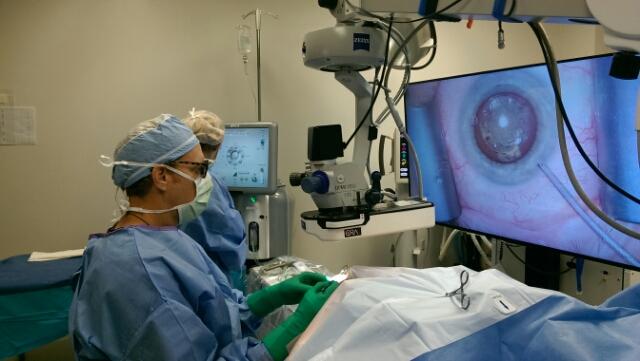Cataract surgery in 3D
Use of heads-up 3D displays does not affect surgical duration or complication rate

Roibeard O’hEineachain
Published: Saturday, June 1, 2019
 Heads-up surgery using the TrueVision 3D system. Courtesy of Vasilios Diakonis
Cataract procedures performed using the TrueVision® three-dimensional display system are as safe and efficient as procedures carried out with conventional binocular surgical microscopes, according to a study presented by Vasilios Diakonis MD, PhD, at the 23rd ESCRS Winter Meeting in Athens, Greece.
The retrospective chart review study included 2,320 eyes of consecutive patients who underwent cataract surgery from August 2016 to July 2017 using either the TrueVision 3D display system or a conventional binocular microscope for visualisation purposes, said Dr Diakonis, Eye Institute of West Florida, Largo, Florida, USA.
In the 3D display group, 870 eyes underwent femtosecond laser-assisted cataract surgery (FLACS) and 803 eyes underwent conventional phacoemulsification surgery. In the conventional microscope group 355 eyes underwent FLACS and 292 eyes underwent traditional phaco. There was no statistically significant difference between the two groups concerning surgical technique, Dr Diakonis noted.
Patients included in the study had cataract without any preoperative clinical findings that could influence the outcomes or duration of surgery. Eyes receiving toric intraocular lenses were also excluded as intraoperative IOL positioning could create a bias for surgical duration, he added.
There was no statistically significant difference between the two groups in terms of surgical duration. The mean surgical time was 6.48 minutes (range, from 3 to 28 min) in the 3D view group and 6.52 min (range, from 3 to 26 min) in the conventional surgical microscope group.
There was also no statistically significant difference between the complications rates of the two groups, which was 0.72% and 0.77% in the 3D view and microscope groups, respectively. Complications for both groups included posterior capsular rapture, vitreous prolapse with need for anterior vitrectomy and three-piece sulcus IOL implantation.
He noted that heads-up surgery with the TrueVision system is more ergonomic than conventional surgery with a binocular research. It does not require the surgeon to lean down to the microscope’s eye pieces, straining the neck and back muscles, which can lead to work-related disability in the long term. In addition, since the whole surgical team has the same view of the surgery, it is useful in training and for the workflow during surgery.
“Heads-up cataract surgery through a three-dimensional visualisation display has similar safety and efficiency to the gold-standard surgical microscope. Implementation of this technology may overcome work-related disabilities and provide a new educational tool in ophthalmology,” Dr Diakonis concluded.
Vasilios Diakonis: diakonis@gmail.com
Heads-up surgery using the TrueVision 3D system. Courtesy of Vasilios Diakonis
Cataract procedures performed using the TrueVision® three-dimensional display system are as safe and efficient as procedures carried out with conventional binocular surgical microscopes, according to a study presented by Vasilios Diakonis MD, PhD, at the 23rd ESCRS Winter Meeting in Athens, Greece.
The retrospective chart review study included 2,320 eyes of consecutive patients who underwent cataract surgery from August 2016 to July 2017 using either the TrueVision 3D display system or a conventional binocular microscope for visualisation purposes, said Dr Diakonis, Eye Institute of West Florida, Largo, Florida, USA.
In the 3D display group, 870 eyes underwent femtosecond laser-assisted cataract surgery (FLACS) and 803 eyes underwent conventional phacoemulsification surgery. In the conventional microscope group 355 eyes underwent FLACS and 292 eyes underwent traditional phaco. There was no statistically significant difference between the two groups concerning surgical technique, Dr Diakonis noted.
Patients included in the study had cataract without any preoperative clinical findings that could influence the outcomes or duration of surgery. Eyes receiving toric intraocular lenses were also excluded as intraoperative IOL positioning could create a bias for surgical duration, he added.
There was no statistically significant difference between the two groups in terms of surgical duration. The mean surgical time was 6.48 minutes (range, from 3 to 28 min) in the 3D view group and 6.52 min (range, from 3 to 26 min) in the conventional surgical microscope group.
There was also no statistically significant difference between the complications rates of the two groups, which was 0.72% and 0.77% in the 3D view and microscope groups, respectively. Complications for both groups included posterior capsular rapture, vitreous prolapse with need for anterior vitrectomy and three-piece sulcus IOL implantation.
He noted that heads-up surgery with the TrueVision system is more ergonomic than conventional surgery with a binocular research. It does not require the surgeon to lean down to the microscope’s eye pieces, straining the neck and back muscles, which can lead to work-related disability in the long term. In addition, since the whole surgical team has the same view of the surgery, it is useful in training and for the workflow during surgery.
“Heads-up cataract surgery through a three-dimensional visualisation display has similar safety and efficiency to the gold-standard surgical microscope. Implementation of this technology may overcome work-related disabilities and provide a new educational tool in ophthalmology,” Dr Diakonis concluded.
Vasilios Diakonis: diakonis@gmail.com